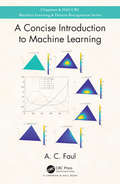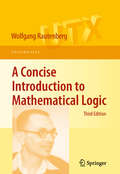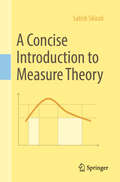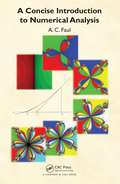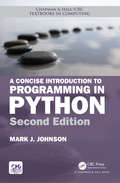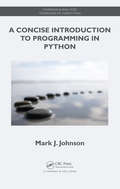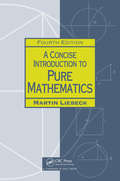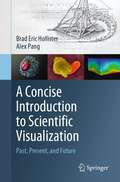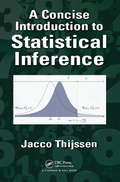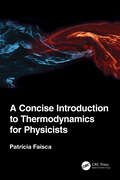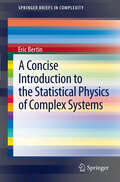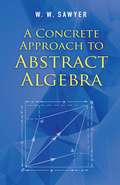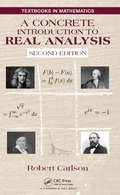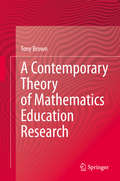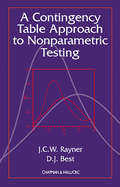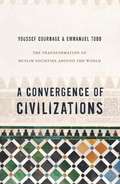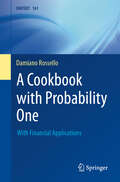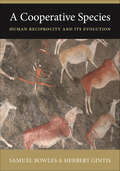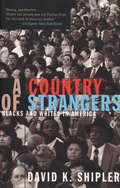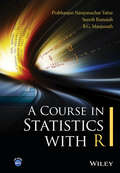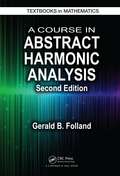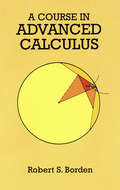- Table View
- List View
A Concise Introduction to Machine Learning
by A.C. FaulThe emphasis of the book is on the question of Why – only if why an algorithm is successful is understood, can it be properly applied, and the results trusted. Algorithms are often taught side by side without showing the similarities and differences between them. This book addresses the commonalities, and aims to give a thorough and in-depth treatment and develop intuition, while remaining concise. This useful reference should be an essential on the bookshelves of anyone employing machine learning techniques. The author's webpage for the book can be accessed here.
A Concise Introduction to Mathematical Logic (Universitext)
by Wolfgang RautenbergTraditional logic as a part of philosophy is one of the oldest scientific disciplines and can be traced back to the Stoics and to Aristotle. Mathematical logic, however, is a relatively young discipline and arose from the endeavors of Peano, Frege, and others to create a logistic foundation for mathematics. It steadily developed during the twentieth century into a broad discipline with several sub-areas and numerous applications in mathematics, informatics, linguistics and philosophy. This book treats the most important material in a concise and streamlined fashion. The third edition is a thorough and expanded revision of the former. Although the book is intended for use as a graduate text, the first three chapters can easily be read by undergraduates interested in mathematical logic. These initial chapters cover the material for an introductory course on mathematical logic, combined with applications of formalization techniques to set theory. Chapter 3 is partly of descriptive nature, providing a view towards algorithmic decision problems, automated theorem proving, non-standard models including non-standard analysis, and related topics. The remaining chapters contain basic material on logic programming for logicians and computer scientists, model theory, recursion theory, Gödel's Incompleteness Theorems, and applications of mathematical logic. Philosophical and foundational problems of mathematics are discussed throughout the text. Each section of the seven chapters ends with exercises some of which of importance for the text itself. There are hints to most of the exercises in a separate file Solution Hints to the Exercises which is not part of the book but is available from the author's website.
A Concise Introduction to Measure Theory
by Satish ShiraliThis undergraduate textbook offers a self-contained and concise introduction to measure theory and integration.The author takes an approach to integration based on the notion of distribution. This approach relies on deeper properties of the Riemann integral which may not be covered in standard undergraduate courses. It has certain advantages, notably simplifying the extension to "fuzzy" measures, which is one of the many topics covered in the book.This book will be accessible to undergraduate students who have completed a first course in the foundations of analysis. Containing numerous examples as well as fully solved exercises, it is exceptionally well suited for self-study or as a supplement to lecture courses.
A Concise Introduction to Numerical Analysis
by A. C. FaulThis textbook provides an accessible and concise introduction to numerical analysis for upper undergraduate and beginning graduate students from various backgrounds. It was developed from the lecture notes of four successful courses on numerical analysis taught within the MPhil of Scientific Computing at the University of Cambridge. The book is easily accessible, even to those with limited knowledge of mathematics.Students will get a concise, but thorough introduction to numerical analysis. In addition the algorithmic principles are emphasized to encourage a deeper understanding of why an algorithm is suitable, and sometimes unsuitable, for a particular problem.A Concise Introduction to Numerical Analysis strikes a balance between being mathematically comprehensive, but not overwhelming with mathematical detail. In some places where further detail was felt to be out of scope of the book, the reader is referred to further reading.The book uses MATLAB® implementations to demonstrate the workings of the method and thus MATLAB's own implementations are avoided, unless they are used as building blocks of an algorithm. In some cases the listings are printed in the book, but all are available online on the book’s page at www.crcpress.com.Most implementations are in the form of functions returning the outcome of the algorithm. Also, examples for the use of the functions are given. Exercises are included in line with the text where appropriate, and each chapter ends with a selection of revision exercises. Solutions to odd-numbered exercises are also provided on the book’s page at www.crcpress.com.This textbook is also an ideal resource for graduate students coming from other subjects who will use numerical techniques extensively in their graduate studies.
A Concise Introduction to Programming in Python (Chapman & Hall/CRC Textbooks in Computing #12)
by Mark J. JohnsonA Concise Introduction to Programming in Python, Second Edition provides a hands-on and accessible introduction to writing software in Python, with no prior programming experience required. The Second Edition was thoroughly reorganized and rewritten based on classroom experience to incorporate: A spiral approach, starting with turtle graphics, and then revisiting concepts in greater depth using numeric, textual, and image data Clear, concise explanations written for beginning students, emphasizing core principles A variety of accessible examples, focusing on key concepts Diagrams to help visualize new concepts New sections on recursion and exception handling, as well as an earlier introduction of lists, based on instructor feedback The text offers sections designed for approximately one class period each, and proceeds gradually from procedural to object-oriented design. Examples, exercises, and projects are included from diverse application domains, including finance, biology, image processing, and textual analysis. It also includes a brief "How-To" sections that introduce optional topics students may be interested in exploring. The text is written to be read, making it a good fit in flipped classrooms. Designed for either classroom use or self-study, all example programs and solutions to odd-numbered exercises (except for projects) are available at: http://www.central.edu/go/conciseintro/.
A Concise Introduction to Programming in Python (Chapman And Hall/crc Textbooks In Computing Ser.)
by Mark J. JohnsonSuitable for newcomers to computer science, A Concise Introduction to Programming in Python provides a succinct, yet complete, first course in computer science using the Python programming language. The book features:Short, modular chapters with brief and precise explanations, intended for one class periodEarly introduction of basic procedural cons
A Concise Introduction to Pure Mathematics (Chapman Hall/crc Mathematics)
by Martin LiebeckAccessible to all students with a sound background in high school mathematics, A Concise Introduction to Pure Mathematics, Fourth Edition presents some of the most fundamental and beautiful ideas in pure mathematics. It covers not only standard material but also many interesting topics not usually encountered at this level, such as the theory of solving cubic equations; Euler’s formula for the numbers of corners, edges, and faces of a solid object and the five Platonic solids; the use of prime numbers to encode and decode secret information; the theory of how to compare the sizes of two infinite sets; and the rigorous theory of limits and continuous functions.
A Concise Introduction to Scientific Visualization: Past, Present, and Future
by Brad Eric Hollister Alex PangScientific visualization has always been an integral part of discovery, starting first with simplified drawings of the pre-Enlightenment and progressing to present day. Mathematical formalism often supersedes visual methods, but their use is at the core of the mental process. As historical examples, a spatial description of flow led to electromagnetic theory, and without visualization of crystals, structural chemistry would not exist. With the advent of computer graphics technology, visualization has become a driving force in modern computing. A Concise Introduction to Scientific Visualization – Past, Present, and Future serves as a primer to visualization without assuming prior knowledge. It discusses both the history of visualization in scientific endeavour, and how scientific visualization is currently shaping the progress of science as a multi-disciplinary domain.
A Concise Introduction to Statistical Inference
by Jacco ThijssenThis short book introduces the main ideas of statistical inference in a way that is both user friendly and mathematically sound. Particular emphasis is placed on the common foundation of many models used in practice. In addition, the book focuses on the formulation of appropriate statistical models to study problems in business, economics, and the social sciences, as well as on how to interpret the results from statistical analyses. The book will be useful to students who are interested in rigorous applications of statistics to problems in business, economics and the social sciences, as well as students who have studied statistics in the past, but need a more solid grounding in statistical techniques to further their careers. Jacco Thijssen is professor of finance at the University of York, UK. He holds a PhD in mathematical economics from Tilburg University, Netherlands. His main research interests are in applications of optimal stopping theory, stochastic calculus, and game theory to problems in economics and finance. Professor Thijssen has earned several awards for his statistics teaching.
A Concise Introduction to Thermodynamics for Physicists
by Patricia FaiscaThis introductory textbook provides a synthetic overview of the laws and formal aspects of thermodynamics and was designed for undergraduate students in physics, and in the physical sciences. Language and notation have been kept as simple as possible throughout the text. While this is a self-contained text on thermodynamics (i.e. focused on macroscopic physics), emphasis is placed on the microscopic underlying model to facilitate the understanding of key concepts such as entropy, and motivate a future course on statistical physics. This book will equip the reader with an understanding of the scope of this discipline and of its applications to a variety of physical systems Throughout the text readers are continuously challenged with conceptual questions that prompt reflection and facilitate the understanding of subtle issues. Each chapter ends by presenting worked problems to support and motivate self-study, in addition to a series of proposed exercises whose solutions are available as supplementary material. Features Pedagogically designed, including illustrations, keyword definitions, highlights, summaries of key ideas and concepts, and boxes with additional topics that complement the materials presented in the main text. Presents active reading strategies, such as conceptual problems, discussion questions, worked examples with comments, end of chapter problems, and further reading to stimulate engagement with the text. Guides the reader with ease through a difficult subject by providing extra help whenever needed to overcome the more demanding technical and conceptual aspects. Solutions Manual available upon qualifying course adoption.
A Concise Introduction to the Statistical Physics of Complex Systems (SpringerBriefs in Complexity)
by Eric BertinThis concise primer (based on lectures given at summer schools on complex systems and on a masters degree course in complex systems modeling) will provide graduate students and newcomers to the field with the basic knowledge of the concepts and methods of statistical physics and its potential for application to interdisciplinary topics. Indeed, in recent years, statistical physics has begun to attract the interest of a broad community of researchers in the field of complex system sciences, ranging from biology to the social sciences, economics and computer science. More generally, a growing number of graduate students and researchers feel the need to learn some basic concepts and questions originating in other disciplines without necessarily having to master all of the corresponding technicalities and jargon. Generally speaking, the goals of statistical physics may be summarized as follows: on the one hand to study systems composed of a large number of interacting 'entities', and on the other to predict the macroscopic (or collective) behavior of the system considered from the microscopic laws ruling the dynamics of the individual 'entities'. These two goals are, to some extent, also shared by what is nowadays called 'complex systems science' and for these reasons, systems studied in the framework of statistical physics may be considered as among the simplest examples of complex systems--allowing in addition a rather well developed mathematical treatment.
A Concise Text on Advanced Linear Algebra
by Yisong YangThis engaging textbook for advanced undergraduate students and beginning graduates covers the core subjects in linear algebra. The author motivates the concepts by drawing clear links to applications and other important areas, such as differential topology and quantum mechanics. The book places particular emphasis on integrating ideas from analysis wherever appropriate. For example, the notion of determinant is shown to appear from calculating the index of a vector field which leads to a self-contained proof of the Fundamental Theorem of Algebra, and the Cayley–Hamilton theorem is established by recognizing the fact that the set of complex matrices of distinct eigenvalues is dense. The material is supplemented by a rich collection of over 350 mostly proof-oriented exercises, suitable for students from a wide variety of backgrounds. Selected solutions are provided at the back of the book, making it suitable for self-study as well as for use as a course text.
A Concrete Approach to Abstract Algebra (Dover Books on Mathematics)
by W. W. SawyerBrief, clear, and well written, this introduction to abstract algebra bridges the gap between the solid ground of traditional algebra and the abstract territory of modern algebra. The only prerequisite is high school–level algebra.Author W. W. Sawyer begins with a very basic viewpoint of abstract algebra, using simple arithmetic and elementary algebra. He then proceeds to arithmetic and polynomials, slowly progressing to more complex matters: finite arithmetic, an analogy between integers and polynomials, an application of the analogy, extending fields, and linear dependence and vector spaces. Additional topics include algebraic calculations with vectors, vectors over a field, and fields regarded as vector spaces. The final chapter proves that angles cannot be trisected by Euclidean means, using a proof that shows how modern algebraic concepts can be used to solve an ancient problem. Exercises appear throughout the book, with complete solutions at the end.
A Concrete Introduction to Real Analysis (Textbooks in Mathematics)
by Robert CarlsonA Concrete Introduction to Analysis, Second Edition offers a major reorganization of the previous edition with the goal of making it a much more comprehensive and accessible for students. The standard, austere approach to teaching modern mathematics with its emphasis on formal proofs can be challenging and discouraging for many students. To remedy this situation, the new edition is more rewarding and inviting. Students benefit from the text by gaining a solid foundational knowledge of analysis, which they can use in their fields of study and chosen professions. The new edition capitalizes on the trend to combine topics from a traditional transition to proofs course with a first course on analysis. Like the first edition, the text is appropriate for a one- or two-semester introductory analysis or real analysis course. The choice of topics and level of coverage is suitable for mathematics majors, future teachers, and students studying engineering or other fields requiring a solid, working knowledge of undergraduate mathematics. Key highlights: Offers integration of transition topics to assist with the necessary background for analysis Can be used for either a one- or a two-semester course Explores how ideas of analysis appear in a broader context Provides as major reorganization of the first edition Includes solutions at the end of the book
A Contemporary Theory of Mathematics Education Research
by Tony BrownThis book by-passes both psychology and sociology to present an original social theory centered on seeing mathematical learning by everyone as an intrinsic dimension of how mathematics develops as a field in support of human activity. Here, mathematics is defined by how we collectively talk about it. Drawing on psychoanalytic theory, the student is seen as participating in the renewal of mathematics through their contributions to our collective gaze on mathematics as the field responds to ever new demands. As such learning takes a critical stance on the standard initiations into current practices often promoted by formal education.In the field of mathematics education, researchers have moved from psychology where individual students were seen as following natural paths of development through existing mathematical knowledge, to socio-cultural models predicated on students being initiated into the human world and understood through the reflective gazes this world has of itself, such as those found in comparisons of student learning in different countries. This book addresses the domain, purpose and functioning of contemporary research in mathematics education and is an original contribution to this theme.The book is aimed at a mathematics education research audience. It continues a dialogue with existing publications, seen widely as a cutting edge and will also be of interest to students and practitioners in the fields of qualitative research, social theory and psychology.
A Contingency Table Approach to Nonparametric Testing
by J.C.W. Rayner D.J. BestMost texts on nonparametric techniques concentrate on location and linear-linear (correlation) tests, with less emphasis on dispersion effects and linear-quadratic tests. Tests for higher moment effects are virtually ignored. Using a fresh approach, A Contingency Table Approach to Nonparametric Testing unifies and extends the popular, standard test
A Continuous Time Econometric Model of the United Kingdom with Stochastic Trends
by Albert Rex Bergstrom Khalid Ben NowmanOver the last thirty years there has been extensive use of continuous time econometric methods in macroeconomic modelling. This 2007 monograph presents a continuous time macroeconometric model of the United Kingdom incorporating stochastic trends. Its development represents a major step forward in continuous time macroeconomic modelling. The book describes the model in detail and, like earlier models, it is designed in such a way as to permit a rigorous mathematical analysis of its steady-state and stability properties, thus providing a valuable check on the capacity of the model to generate plausible long-run behaviour. The model is estimated using newly developed exact Gaussian estimation methods for continuous time econometric models incorporating unobservable stochastic trends. The book also includes discussion of the application of the model to dynamic analysis and forecasting.
A Convergence of Civilizations: The Transformation of Muslim Societies Around the World
by Youssef Courbage Emmanuel ToddWe are told that Western/Christian and Muslim/Arab civilizations are heading towards inevitable conflict. The demographics of the West remain sluggish, while the population of the Muslim world explodes, widening the cultural gap and all but guaranteeing the outbreak of war. Leaving aside the media's sound and fury on this issue, measured analysis shows another reality taking shape: rapprochement between these two civilizations, benefiting from a universal movement with roots in the Enlightenment. The historical and geographical sweep of this book discredits the notion of a specific Islamic demography. The range of fertility among Muslim women, for example, is as varied as religious behavior among Muslims in general. Whether agnostics, fundamentalist Salafis, or al-Qaeda activists, Muslims are a diverse group that prove the variety and individuality of Islam. Youssef Courbage and Emmanuel Todd consider different degrees of literacy, patriarchy, and defensive reactions among minority Muslim populations, underscoring the spread of massive secularization throughout the Arab and Muslim world. In this regard, they argue, there is very little to distinguish the evolution of Islam from the history of Christianity, especially with Muslims now entering a global modernity. Sensitive to demographic variables and their reflection of personal and social truths, Courbage and Todd upend a dangerous meme: that we live in a fractured world close to crisis, struggling with an epidemic of closed cultures and minds made different by religion.
A Cookbook with Probability One: With Financial Applications (UNITEXT #161)
by Damiano RosselloThis book offers accessible probabilistic modelling of relevant financial problems. It is divided into two parts. The first part (cookbook) is written by emphasizing the key definitions and theorems without wasting too much of the reader with unnecessary technical details. Here, the first kind of target audience is graduate students in Economics with no prior exposition to probability theory (except for undergraduate courses in Applied Statistics) which are provided by a self-contained account of probabilistic modelling mainly applied to finance. The fundamental concepts of random variable/vector and probability distributions are introduced beforehand with respect to the usual treatment of this subject in standard probability textbook, trying to strike a balance between precise mathematical definitions and their applied knowledge. All the analytic tools developed are illustrated through examples of probability distributions of future stock prices, returns and profit and loss, together with their main characteristics, such as moments, moment generating and characteristic functions, location-scale families, and quantiles. The extension to the multivariate case for fixed time horizons is presented, together with the fundamentals of stochastic processes both in discrete and continuous time as candidate models for asset prices and return dynamics. Convergence concepts are presented as applied to the problem of point estimation of means, variances, correlation coefficients and risk measures. Short sections on risk and copula functions, further illustrate the potential application of probability models to financial problems. The second part of the book can be accessed by those students with more mathematical preparation. All the relevant proofs of results which are only stated in the first part and some advanced exercises with complete solutions are presented.
A Cooperative Species: Human Reciprocity and Its Evolution
by Samuel Bowles Herbert GintisA fascinating look at the evolutionary origins of cooperationWhy do humans, uniquely among animals, cooperate in large numbers to advance projects for the common good? Contrary to the conventional wisdom in biology and economics, this generous and civic-minded behavior is widespread and cannot be explained simply by far-sighted self-interest or a desire to help close genealogical kin.In A Cooperative Species, Samuel Bowles and Herbert Gintis—pioneers in the new experimental and evolutionary science of human behavior—show that the central issue is not why selfish people act generously, but instead how genetic and cultural evolution has produced a species in which substantial numbers make sacrifices to uphold ethical norms and to help even total strangers.The authors describe how, for thousands of generations, cooperation with fellow group members has been essential to survival. Groups that created institutions to protect the civic-minded from exploitation by the selfish flourished and prevailed in conflicts with less cooperative groups. Key to this process was the evolution of social emotions such as shame and guilt, and our capacity to internalize social norms so that acting ethically became a personal goal rather than simply a prudent way to avoid punishment.Using experimental, archaeological, genetic, and ethnographic data to calibrate models of the coevolution of genes and culture as well as prehistoric warfare and other forms of group competition, A Cooperative Species provides a compelling and novel account of how humans came to be moral and cooperative.
A Country of Strangers: Blacks and Whites in America
by David K. ShiplerA Country of Strangers is a magnificent exploration of the psychological landscape where blacks and whites meet. To tell the story in human rather than abstract terms, the Pulitzer Prize-winning writer David K. Shipler bypasses both extremists and celebrities and takes us among ordinary Americans as they encounter one another across racial lines.We learn how blacks and whites see each other, how they interpret each other's behavior, and how certain damaging images and assumptions seep into the actions of even the most unbiased. We penetrate into dimensions of stereotyping and discrimination that are usually invisible, and discover the unseen prejudices and privileges of white Americans, and what black Americans make of them.We explore the competing impulses of integration and separation: the reference points by which the races navigate as they venture out and then withdraw; the biculturalism that many blacks perfect as they move back and forth between the white and black worlds, and the homesickness some blacks feel for the comfort of all-black separateness. There are portrayals of interracial families and their multiracial children--expert guides through the clashes created by racial blending in America. We see how whites and blacks each carry the burden of our history.Black-white stereotypes are dissected: the physical bodies that we see, the mental qualities we imagine, the moral character we attribute to others and to ourselves, the violence we fear, the power we seek or are loath to relinquish.The book makes clear that we have the ability to shape our racial landscape--to reconstruct, even if not perfectly, the texture of our relationships. There is an assessment of the complexity confronting blacks and whites alike as they struggle to recognize and define the racial motivations that may or may not be present in a thought, a word, a deed. The book does not prescribe, but it documents the silences that prevail, the listening that doesn't happen, the conversations that don't take place. It looks at relations between minorities, including blacks and Jews, and blacks and Koreans. It explores the human dimensions of affirmative action, the intricate contacts and misunderstandings across racial lines among coworkers and neighbors. It is unstinting in its criticism of our society's failure to come to grips with bigotry; but it is also, happily, crowded with black people and white people who struggle in their daily lives to do just that.A remarkable book that will stimulate each of us to reexamine and better understand our own deepest attitudes in regard to race in America.
A Course In Mathematical Analysis
by D. J. H. GarlingThe three volumes of A Course in Mathematical Analysis provide a full and detailed account of all those elements of real and complex analysis that an undergraduate mathematics student can expect to encounter in their first two or three years of study. Containing hundreds of exercises, examples and applications, these books will become an invaluable resource for both students and instructors. This first volume focuses on the analysis of real-valued functions of a real variable. Besides developing the basic theory it describes many applications, including a chapter on Fourier series. It also includes a Prologue in which the author introduces the axioms of set theory and uses them to construct the real number system. Volume II goes on to consider metric and topological spaces and functions of several variables. Volume III covers complex analysis and the theory of measure and integration.
A Course In Statistics With R
by Prabhanjan N. Tattar Suresh Ramaiah B. G. ManjunathIntegrates the theory and applications of statistics using R "A Course in Statistics with R" has been written to bridge the gap between theory and applications and explain how mathematical expressions are converted into R programs. The book has been primarily designed as a useful companion for a Masters student during each semester of the course, but will also help applied statisticians in revisiting the underpinnings of the subject. With this dual goal in mind, the book begins with R basics and quickly covers visualization and exploratory analysis. Probability and statistical inference, inclusive of classical, nonparametric, and Bayesian schools, is developed with definitions, motivations, mathematical expression and R programs in a way which will help the reader to understand the mathematical development as well as R implementation. Linear regression models, experimental designs, multivariate analysis, and categorical data analysis are treated in a way which makes effective use of visualization techniques and the related statistical techniques underlying them through practical applications, and hence helps the reader to achieve a clear understanding of the associated statistical models. "Key features" Integrates R basics with statistical concepts Provides graphical presentations inclusive of mathematical expressions Aids understanding of limit theorems of probability with and without the simulation approach Presents detailed algorithmic development of statistical models from scratch Includes practical applications with over 50 data sets
A Course in Abstract Harmonic Analysis (Textbooks in Mathematics)
by Gerald B. FollandA Course in Abstract Harmonic Analysis is an introduction to that part of analysis on locally compact groups that can be done with minimal assumptions on the nature of the group. As a generalization of classical Fourier analysis, this abstract theory creates a foundation for a great deal of modern analysis, and it contains a number of elegant resul
A Course in Advanced Calculus (Dover Books on Mathematics)
by Robert S. BordenThis remarkable undergraduate-level text offers a study in calculus that simultaneously unifies the concepts of integration in Euclidean space while at the same time giving students an overview of other areas intimately related to mathematical analysis. The author achieves this ambitious undertaking by shifting easily from one related subject to another. Thus, discussions of topology, linear algebra, and inequalities yield to examinations of innerproduct spaces, Fourier series, and the secret of Pythagoras. Beginning with a look at sets and structures, the text advances to such topics as limit and continuity in En, measure and integration, differentiable mappings, sequences and series, applications of improper integrals, and more.Carefully chosen problems appear at the end of each chapter, and this new edition features an additional appendix of tips and solutions for selected problems.
